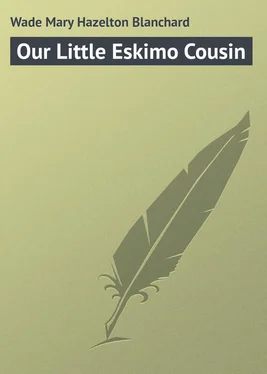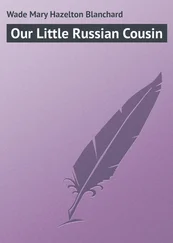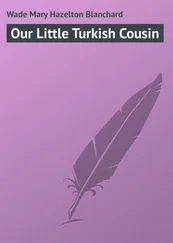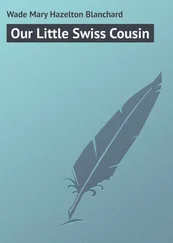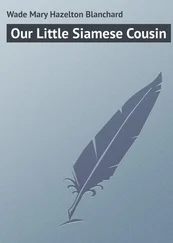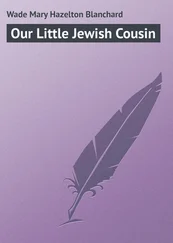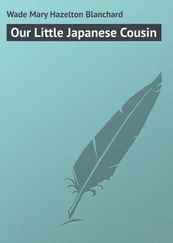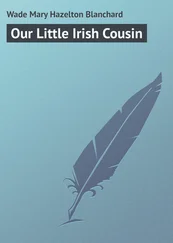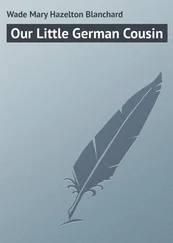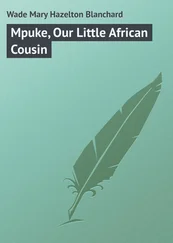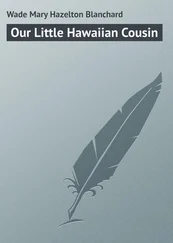Mary Wade - Our Little Eskimo Cousin
Здесь есть возможность читать онлайн «Mary Wade - Our Little Eskimo Cousin» — ознакомительный отрывок электронной книги совершенно бесплатно, а после прочтения отрывка купить полную версию. В некоторых случаях можно слушать аудио, скачать через торрент в формате fb2 и присутствует краткое содержание. Жанр: foreign_prose, foreign_children, foreign_language, на английском языке. Описание произведения, (предисловие) а так же отзывы посетителей доступны на портале библиотеки ЛибКат.
- Название:Our Little Eskimo Cousin
- Автор:
- Жанр:
- Год:неизвестен
- ISBN:нет данных
- Рейтинг книги:4 / 5. Голосов: 1
-
Избранное:Добавить в избранное
- Отзывы:
-
Ваша оценка:
- 80
- 1
- 2
- 3
- 4
- 5
Our Little Eskimo Cousin: краткое содержание, описание и аннотация
Предлагаем к чтению аннотацию, описание, краткое содержание или предисловие (зависит от того, что написал сам автор книги «Our Little Eskimo Cousin»). Если вы не нашли необходимую информацию о книге — напишите в комментариях, мы постараемся отыскать её.
Our Little Eskimo Cousin — читать онлайн ознакомительный отрывок
Ниже представлен текст книги, разбитый по страницам. Система сохранения места последней прочитанной страницы, позволяет с удобством читать онлайн бесплатно книгу «Our Little Eskimo Cousin», без необходимости каждый раз заново искать на чём Вы остановились. Поставьте закладку, и сможете в любой момент перейти на страницу, на которой закончили чтение.
Интервал:
Закладка:
Mary Hazleton Wade
Our Little Eskimo Cousin
Preface
It is a very wonderful thing, when we stop to think of it, that no matter where we are placed in this great round world of ours, it seems just right to us.
Far away in the frozen north, where the lovely aurora borealis dances in the sky, where the long sunless winter night stretches halfway across the year, live a people who cannot keep themselves alive without working very hard. Yet they are happy and fun-loving. They make pleasures for themselves. They are patient and joyous in the midst of darkness and storm. They do not think of complaining at their hard lot, or that they do not live where Nature is kinder and more generous.
We call them Eskimos. They belong to another race than ours, – a different branch of the great human family. They are yellow and we are white, to be sure. But we know that, no matter how far away any race of people lives, and no matter how different these people may be from us in looks and habits, they and we belong to the same great family. It includes every race and every colour, for we are the children of one Father.
What a pleasure it is, therefore, to travel from place to place and see more of the life of others! But suppose we cannot journey with our bodies; we need not stay at home on that account. Let us use the wings of the mind, and without trouble or expense visit the hot lands and the cold, the yellow children and the red. Let us know them and learn what they can teach us.
CHAPTER I.
BABY DAYS
A pair of very bright black eyes peered out from the mother's hood that winter morning. The thermometer, if there had been one, would have shown the temperature to be seventy degrees below the freezing point.
Yet baby Etu did not seem to care. He was nestled so warmly in the heavy furs, and felt so safe on his mother's broad back, that he laughed and crowed in pure delight.
It was his first ride since he was born, and there was so much to look at! At least he thought so, though great sheets of snow stretched outward to the frozen ocean, and covered the land in every direction. The twinkling stars gave the only light for Etu to see by, yet it was daytime. It was that part of the twenty-four hours when the baby's people did their work; and that must be called day in Etu's far northern country, even though darkness covers all the land.
For Etu lives in the frozen zone, on the shores of northern Alaska, and during the long winter of eight months the sun shows his face very little above the horizon.
Here and there the snow looked as if it had been raised into low mounds. Near these mounds holes could be seen in the ground, and pathways dug out between them. There were no trees, no fences, no roads.
Where was the village, and where was the baby's home? Those holes marked the entrances to the winter houses built by Etu's father and his neighbours. The mounds were the coverings of the houses. Great pits had been dug in the earth, and lined with driftwood which had floated on to the shore. Jaws of whales made the framework of the roofs, these being covered with sods cut out of the marshy plains in summer. Mother Nature did the rest by protecting all with a warm close blanket of snow.
At first it makes one shudder to think of living in such homes during the long Arctic winter. But the Eskimos are satisfied, and feel so comfortable that they remove a great part of their clothing while they are indoors. The houses are made so snug that the sharpest winds cannot enter, and they cost nothing but the labour of making them.
Etu's mother allowed him to stay out only a few minutes this first time. She soon turned toward home, and coming to her own doorway crawled down through a long slanting tunnel in the ground, eight or ten feet long. When she reached the end, she was obliged to stoop even lower, for now she must pass upwards through another passage. Lifting a trap-door, she stepped at once into the middle of her own home.
Why was there such a queer entrance? Because the wind must be kept out at all hazards. After all, it seemed easy and natural enough to this woman who had never known other and pleasanter hallways.
How close it seemed after the fresh cold air outdoors! There was a strong odour of smoking oil. It was noisy, too, as other women and children were moving around inside, for the house was shared in common by several families who were friendly to each other, and enjoyed living together.
Etu's mother quickly took off her outer coat of sealskin, and, lifting her baby out of his warm nest, placed him on a platform which stretched along one side of the room. What a round, smiling dumpling he was! His face was broad and flat, while his little nose looked as though it had been punched inwards. His bright eyes were quite narrow.
He wore a curious skin cap drawn tightly over the top of his head. He must keep this on night and day for a year, at least. It would make his forehead taper upward, and that is a mark of beauty among his people. As soon as he was born, the top of his head was pressed between his nurse's hands, and the cap fitted on at once so that his head might grow in the proper shape. After that operation he was taken outdoors, and rolled in the snow. I suppose that was to get him used to the cold climate of his birthplace. Don't you?
Baby Etu's skin was much whiter than his mother's, – very nearly as white, in fact, as your own little brother's. Why has he changed so much since he has grown to be a big boy? Listen to the strange reason.
When our Eskimo cousin was born, there was a small dark spot on his back. Day by day it grew larger; the change came very slowly, so slowly it could scarcely be noticed. But at last the darker colour had spread over the boy's whole body, till his skin was nearly like that of his father and mother.
In course of time it would grow darker still, because he did not wash himself. Please don't be shocked. It is so hard to get water in that frozen land. Snow must first be melted, and to do this heat is required. Heating requires the burning of oil, and oil is very precious. It is scarcely any wonder, therefore, that Etu has not been taught to be cleanly in all ways.
The smoky air of the home during the long winter months also made the boy's skin grow darker. Sometimes during his babyhood his mother would wash him as a mother cat washes her kittens, but that was all he has ever known of the delights of a bath. The mother-love made that pleasant, perhaps, but we cannot envy him.
It was quite surprising to an Arctic explorer some years ago, when he discovered the difference soap and warm water would make in an Eskimo's appearance.
"Why, you are almost a white man," he exclaimed, "your friends will think you have been changed into another being by some magical spell." And he laughed heartily when he thought of the only magic being soap and water.
Etu tumbled about on the sealskins which covered the platform, watching his mother while she trimmed the wick of the lamp. What an odd-looking lamp it was! It was made of a crescent-shaped stone hollowed out. Think of the labour of making it! It must have taken days, and even weeks, before the cavity was hollowed enough to hold the oil. But Etu's people are such patient workers they do not worry over the time they spend.
Moss was built up around the sides of the lamp; it served for the wick which spluttered away as the oil burned and warmed the room. A lump of seal fat, or blubber as it is called, hung over the lamp. As it melted slowly in the heat, it dripped down into the cavity and furnished a steady supply of oil.
There were two other lamps burning in Etu's home, for you must remember there was a very large family living here. And these queer lamps not only gave light and warmth to all these people, but the cooking must also be done over them.
Читать дальшеИнтервал:
Закладка:
Похожие книги на «Our Little Eskimo Cousin»
Представляем Вашему вниманию похожие книги на «Our Little Eskimo Cousin» списком для выбора. Мы отобрали схожую по названию и смыслу литературу в надежде предоставить читателям больше вариантов отыскать новые, интересные, ещё непрочитанные произведения.
Обсуждение, отзывы о книге «Our Little Eskimo Cousin» и просто собственные мнения читателей. Оставьте ваши комментарии, напишите, что Вы думаете о произведении, его смысле или главных героях. Укажите что конкретно понравилось, а что нет, и почему Вы так считаете.
